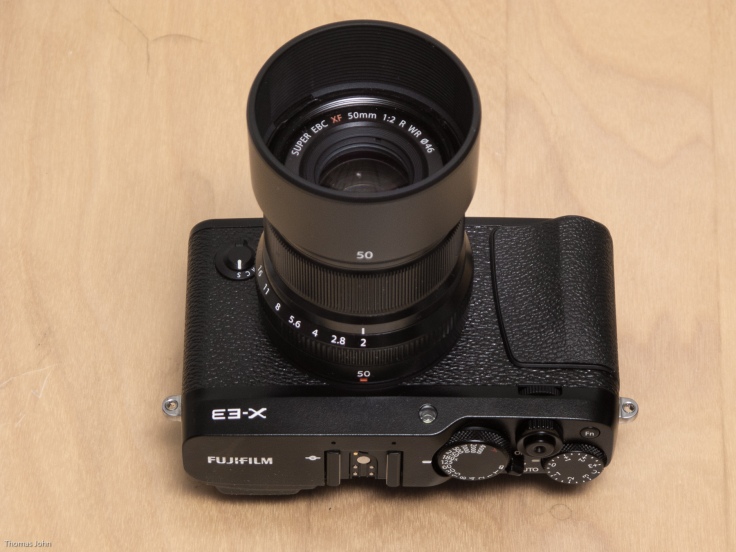The 50/2 is currently the longest of the three Fujicrons, this being an inofficial name for Fuji’s compact f/2 lenses, based on Leica’s famed Summicron lineup. As of late 2017, Fuji also offers a 23/2 and a 35/2. These three lenses are virtually identical in barrel design, size and weight. Read more about this trio on James’ Fujicron info page.
This will be a short review, well cause I think there’s not that much to say about this nice lens. It does what it should, it’s very good, and it’s a joy to look at and great in use. Mechanically, all the Fujicrons are equally beautifully made. They are lightweight, yet feel exceptionally well made. They are not overdone in any way, no flashy silver rings or anything, and the included lens hoods are made from plastic – some hate that, but I love it. Plastic is a much better protection against small bumps (like when you carry your camera on an R-strap and move through a crowd, stuff like that). Optically, the 23/2 and 50/2 are very well and also come with very low distortion (the 35/2 is different here, it heavily relies on digital distortion correction). Both these lenses retail for €499 but might be found as very young used lenses for around €350-400 each.
The only criticism: Why does the 23/2 come with 43 mm filter threads and the 50/2 has 46 mm? Come on, Fuji. You can do better than that!

So what else is there to say? Get these two if you like the idea of a lightweight 35 + 75 mm setup (in classic 35 mm film terms). I’d personally not buy the third Fujicron, the 35/2, but always go for the Fujinon 35/1.4 instead – especially if you shop for a well-kept used example, well worth the small premium over the 35/2.
Small sample photo gallery – processed with RAW Therapee
Now here are some pictures that I took with the 50/2 on the X-E3. All these I took as RAW and processed with the RAW Therapee converter. If you are used to modern, polished, professional software like Lightroom, the RAW Therapee user interface takes you back some 15 years maybe. And you have to open and edit one single file after the other.
On the other hand, you’ll get very authentic results: RAW Therapee ignores all digital correction data that the camera manufacturers might add to their RAW files. So, no light falloff or distortion correction. You get what the lens itself is capable to deliver. Personally, I really like that approach. In addition, RAW Therapee is available for Linux, a system that sadly suffers from a notoriously bad selection of RAW converters. And it’s completely cost-free. So, give it a try!
All these shots above were taken at f/2 aperture. Those pictures with buildings in them I’d normally shoot at a more closed aperture, but in this case I was in moving train and had to take the pictures through the window – so a really short shutter time was necessary and I did not want ISO to go up too much.
Verdict
Again, there was no digital correction used (that Fuji includes in the RAW files) thanks to the RAW converter that I used. Thus, no correction of chromatic abberations, corner falloff or distortion. The pictures above show what the lens delivers. I don’t see anything to compain there. Sharpness, great contrast, nice colors (maybe you have to forgive me, not the lens or camera, for being a bit clumsy with RAW Therapee’s white balance function).
What I especially like is how fast the lens focuses on the X-E3. Coming from the Olympus PEN-F, I do think focussing is just a little bit more instant. Thinking of it, that would make perfect sense as the Fuji offers on-sensor phase-detection auto focus and the Olympus doesn’t. This means that the Fuji instantly knows in which direction it has to move the lens to adjust the focus.
The one thing I noticed – this is only an f/2 lens. Not a f/1.4 or even f/1.2. So it won’t throw background detail out of focus in a really dramatic way. Fuji offers a (big and expensive) 56/1.2 if you are after that. This 50/2, on the other hand, equals a 75/2.8 in classic 35 mm film camera terms. So, it’s not that dramatic, but you definitely still have some freedom to play with soft backgrounds.
For the Fujis, this lens is quite bit like the mighty Contax G 90/2.8 was on my Sony A7 series. The Contax 90 mm was just a bit longer in terms of focal length. Right now I actually think that the Fuji’s 75 mm equivalent field of view might be even just a bit more universal. Anyway, I deeply loved that G 90/2.8 (and hated the failing AF adapter on my Sony camera). I am curious if I’ll like the Fujicron 50/2 just as much.









